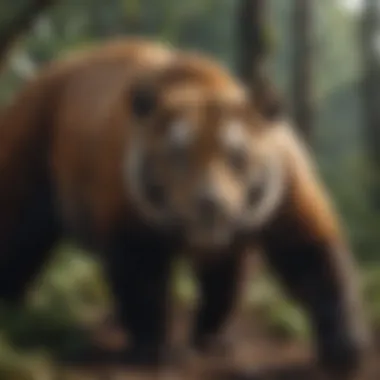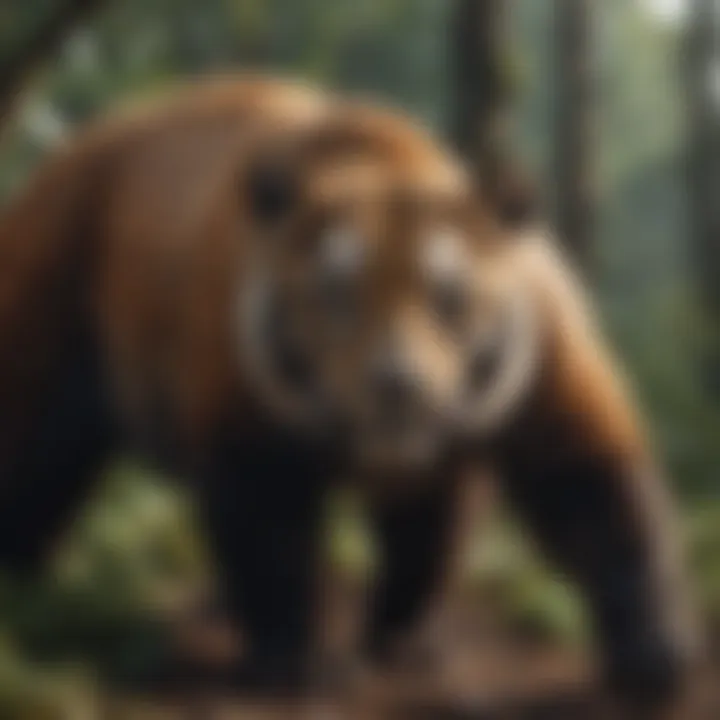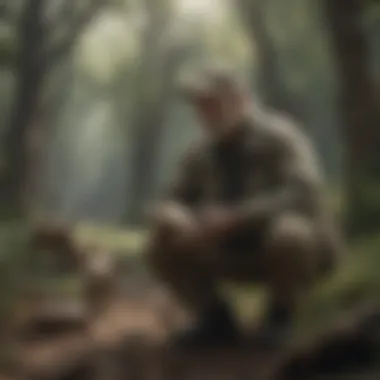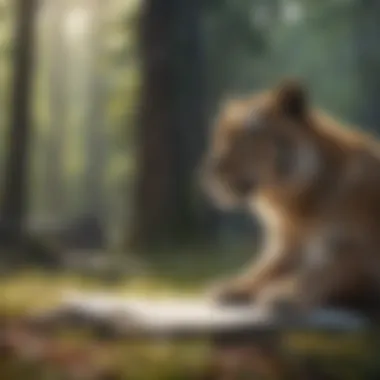Effective Strategies to Protect Endangered Species


Intro
As the fabric of our ecosystems continues to fray, the decline of endangered species remains a pressing challenge that resonates across the globe. Understanding that these species act as indicators of ecological health, the urgency to develop effective strategies becomes undeniable. From the majestic snow leopards trekking through mountain ranges to the tiniest amphibians in lush rainforests, each species plays a vital role in its ecosystem. Without them, the balance we often take for granted begins to tip. Protecting these species is not merely about conserving wildlife; it’s about safeguarding the intricate tapestry of life we all depend on.
Contemporary conservation efforts are multifaceted, requiring a blend of scientific research, community engagement, and legislative action. The complexities involved in halting the decline of endangered species necessitate a comprehensive strategy informed by the latest research and practices. In this article, we will explore the various avenues available for conservationists, educators, and policymakers alike, aiming to enhance public awareness while encouraging grassroots involvement. By diving into specific examples and exploring successful case studies, we hope to showcase how community-driven initiatives can complement governmental legislation.
We will also touch upon the innovative methods emerging from ongoing research that highlight how modern technology and age-old practices can unite. Before embarking on this journey towards conservation, it’s essential to understand the current landscape of endangered species and review the tactics proven effective in fighting this critical battle.
Understanding Endangered Species
The plight of endangered species is a pressing issue that stirs the conscience of many. It's important to grasp what it means for a species to be endangered and why this matters not just to biodiversity, but also to the very fabric of ecosystems. When a species is classified as endangered, it suggests a significant risk of extinction, making it a crucial focal point for conservationists and policymakers alike. The protection of these species functions as a bellwether for environmental health, signaling that if they decline, other species may follow suit.
In delving deeper into this topic, we can identify several key facets:
- The intrinsic value of biodiversity: Every species plays a unique role within its ecosystem, contributing to ecological balance and resilience.
- The economic significance: Biodiverse ecosystems provide resources essential for human survival, contributing to industries such as agriculture, forestry, and tourism.
- The cultural and historical links: Many species hold cultural significance for communities, shaping identities and traditions.
Understanding these layers helps us appreciate not only what is at stake but also empowers us to contribute to solutions. When someone recognizes the characteristics and challenges of endangered species, they are more likely to engage in conservation efforts both locally and globally.
Underlying Causes of Endangerment
Understanding the underlying causes of endangerment is crucial for crafting effective strategies to counteract species decline. It's not just about knowing what is affecting these species, but also unraveling why these factors are at play in the first place. This knowledge allows for targeted conservation efforts that can address the root issues rather than merely treating symptoms.
Habitat Destruction
Habitat destruction stands as one of the primary culprits in the decline of many species. The expansion of urban areas, agricultural practices, and infrastructure projects all carve into natural habitats, often leaving wildlife without homes. For instance, in places like the Amazon rainforest, vast stretches are cleared for farming or logging, drastically reducing the space available for countless species. When you strip away the layers of biodiversity, the effects seem like a domino fall— one species goes, and others follow in its wake.
A stark example is the plight of the orangutan, whose rainforest habitat is rapidly vanishing due to palm oil plantation expansion. As they lose their homes, the chances of breeding decrease, leading to even steeper population declines. Addressing habitat destruction means more than just protecting existing areas; it also involves rehabilitating environments that have been damaged, ensuring wildlife has the corridors needed to thrive.
- Key points regarding Habitat Destruction:
- Urbanization and development increase land fragmentation.
- Agriculture often prioritizes profits over ecological balance.
- Ecological restoration can help recover some lost habitats.
Pollution and Climate Change
Pollution and climate change are intertwined issues that worsen the plight of endangered species. Chemicals released into the air, soil, and water can alter ecosystems and render them inhospitable. For instance, marine animals face dire consequences due to plastic waste and other pollutants. Coral reefs, crucial for many aquatic species, suffer from ocean acidification as a result of climate change, weakening their structures and disturbing the entire marine food chain.
In an ice-capped land such as the Arctic, species like polar bears are facing the brunt of rising temperatures. As ice melts due to climate change, their hunting grounds diminish, and with that, their survival becomes increasingly precarious. Moreover, shifting seasonal patterns disrupt migration and breeding cycles, presenting additional hurdles for species already on the brink.
- Important considerations:
- Pollution adversely affects reproduction and growth in various species.
- Climate change disrupts seasonal behaviors critical for survival.
- Strategies must encompass pollution reduction and climate adaptability.
Overexploitation and Illegal Trade
Overexploitation and illegal trade represent a two-headed threat to the world's biodiversity. Many species are hunted or harvested at rates that exceed their reproductive capacities, leading to population crashes. Particularly alarming is the illegal wildlife trade, which operates under a shroud of secrecy and fear. For example, the demand for elephant ivory continues to jeopardize the survival of these majestic creatures, as poachers capitalize on the lucrative market.
In many cases, the ramifications extend beyond endangerment. As certain species disappear, their absence can trigger significant ecological shifts, affecting other species within the ecosystem. For instance, the decline of top predators often leads to overpopulation of prey species, triggering imbalances that ripple through the food web.
- Key factors in Overexploitation and Illegal Trade:
- Illegal trade thrives on economic demand and lack of enforcement.
- Sustainable practices and regulatory frameworks can help mitigate overexploitation.
- Education regarding the importance of species preservation is vital for changing societal behaviors.
"Protecting endangered species requires a multifaceted understanding of all the underlying causes of decline. This holistic approach is essential for crafting effective conservation strategies."
By dissecting the root causes of endangerment, we gain valuable insights that direct our conservation efforts. To truly make a difference, it is imperative to tackle these foundational issues head-on, ultimately fostering healthier ecosystems and, thereby, a more stable future for endangered species.
Legal Framework for Protection
The legal framework for the protection of endangered species is a cornerstone of conservation efforts globally. It serves as a vital mechanism that establishes the guidelines for the preservation of biodiversity. Without these frameworks, efforts to protect various species would lack enforceability and coherence, leading to further decline.
The importance of this legal context cannot be overstated. Legal measures help set standards for how various entities—governments, organizations, and even individuals—interact with wildlife. They also support the establishment of protected areas, promote research initiatives, and ensure that stakeholders are held accountable for their actions. When it comes to conservation, having strong legal backing acts like a double-edged sword; it not only deters harmful practices but also promotes responsible stewardship of natural resources. Ultimately, it's about ensuring that our biological heritage is not merely a footnote in a history book.
International Treaties
CITES
The Convention on International Trade in Endangered Species of Wild Fauna and Flora, or CITES for short, is a pivotal global agreement designed to ensure that international trade does not threaten the survival of endangered species. One significant aspect of CITES is its ability to regulate trade across borders. It focuses on listing species and their respective levels of protection based on risk assessments.
The key characteristic of CITES is its tiered approach, where species are listed in three appendices. Appendix I includes species threatened with extinction, while Appendix II and III offer varying degrees of control over trade. This structured method makes it a beneficial choice for protecting species by regulating and monitoring their trade. Moreover, this framework facilitates cooperation among countries, creating a united front.


A unique feature of CITES is its emphasis on capacity-building. While there are advantages in regulating trade, one downside is that enforcement can be weak in some countries, often due to lack of resources or political will. Without proper implementation, even the best treaties can fall flat.
Convention on Biological Diversity
Another significant legal tool is the Convention on Biological Diversity (CBD). This treaty emphasizes the preservation of biodiversity, utilizing a holistic approach that brings attention to not just individual species but entire ecosystems and habitats. The CBD primarily focuses on the sustainable use of biological resources as well as the fair and equitable sharing of benefits arising from the use of genetic resources.
A critical aspect of the CBD is its emphasis on involving various stakeholders, including indigenous communities, in decision-making processes. This characteristic makes it a popular choice for countries aiming for a comprehensive conservation strategy. The collective wisdom of local communities often leads to innovative conservation solutions, thanks to their long-standing relationship with the land.
However, one unique advantage of the CBD is its framework for monitoring and reporting on biodiversity. Still, it's not without its downsides; the effectiveness of implementation varies greatly among countries, largely dependent on national priorities and policies.
National Legislation
Endangered Species Act
In the United States, the Endangered Species Act (ESA) represents a robust national framework aimed at protecting imperiled species and their habitats. One significant aspect of the ESA is its ability to designate critical habitats, which are essential for the survival and recovery of endangered species.
The ESA's key characteristic lies in its strong legal protections. Notably, it prohibits hunting, capturing, or harassing endangered species and makes it illegal to destroy their habitats. This makes it a beneficial tool in the arsenal of conservationists. Moreover, it empowers citizens by allowing them to sue for enforcement, making accountability a core principle of the act.
Unique features of the ESA include its provision for recovery plans tailored to individual species, outlining the measures necessary for their survival. While successful in some instances, a notable downside is its contentious aspects, often leading to conflicts with development interests.
Wildlife Protection Laws
Other countries have enacted their own Wildlife Protection Laws, which vary widely in scope and effectiveness. One critical aspect of these laws is their ability to create legal frameworks tailored to local conditions. Depending on the local fauna and flora, different species may be prioritized based on the degree of threat they face.
A key strength of wildlife protection laws is their focus on habitat conservation alongside species protection, making them a valuable choice for holistic conservation efforts. Through these laws, local governments can promote community engagement, encouraging citizens to take proactive measures in conservation.
An interesting feature of some wildlife protection laws is their framework for penalties and fines that are imposed for breaches; this acts as a deterrent against illegal activities. However, the effectiveness can suffer from inadequate implementation and enforcement mechanisms, particularly in regions plagued by corruption or lack of resources.
"Legal frameworks are crucial for creating the safety nets that endangered species need to thrive, but they must be enacted with diligence and commitment for real change to happen."
In summary, the legal frameworks—both international treaties and national laws—serve as essential pillars in the effort to halt the decline of endangered species. They not only create binding obligations but also promote accountability, ultimately ensuring that biodiversity is preserved for generations to come.
Conservation Strategies
Conservation strategies are crucial in the fight against the decline of endangered species. They encompass a range of actions aimed at protecting biodiversity and ensuring the survival of species facing extinction. These strategies are not just about preserving individual species but also about maintaining ecological balance and the health of entire ecosystems. By implementing conservation strategies, we can address threats like habitat loss, pollution, and overexploitation. This holistic approach leads to sustainable outcomes, allowing nature to regenerate and species to thrive once more.
Habitat Restoration
Reforestation
Reforestation plays a significant role in conservation strategies. It involves planting trees in areas where forests have been cut down or degraded. Forests are vital ecosystems that provide habitat for numerous species, maintain soil health, and regulate water cycles. Without trees, many of these processes collapse, putting various species at risk.
The key characteristic of reforestation is that it not only benefits wildlife but also contributes to human well-being by improving air quality and reducing flooding. Moreover, when local communities are involved, it builds a connection between them and nature, fostering stewardship and responsibility toward environmental health.
One unique feature of reforestation is its potential for carbon sequestration, which helps combat climate change. But, reforestation has its challenges. Issues such as choosing the right species to plant and ensuring biodiversity can complicate efforts. However, when done right, the upsides are tremendous, linking communities, wildlife, and the environment in a symbiotic relationship.
Wetland Recovery
Wetland recovery represents another crucial strategy in conservation. Wetlands are rich ecosystems that provide vital resources for many species, acting as natural buffers against flooding and storm surges. They serve as breeding grounds for a variety of life forms, including many fish and bird species essential for biodiversity.
A defining characteristic of wetland recovery is its ability to filter pollutants from water, improving overall water quality in the surrounding environment. This filtering process removes harmful substances, benefiting not just wildlife but also human communities that depend on clean water.
What makes wetland recovery a notable choice is its potential to create a network of interconnected ecosystems that enhance resilience against environmental changes. However, challenges remain—such as funding and ongoing maintenance are often cited as significant hurdles. Despite these issues, the advantages of healthy wetlands far outweigh the drawbacks, making them indispensable in the quest to halt species decline.
Protected Areas and Reserves
Establishing protected areas and reserves is one of the most straightforward strategies for conservation. These spaces safeguard habitats and provide a safe haven for flora and fauna at risk of extinction. The establishment of parks, marine reserves, and wildlife sanctuaries promotes biodiversity conservation by limiting human activities that endanger these species.
The beauty of protected areas is their dual role. They not only conserve wildlife but also can serve as sites for ecotourism, which can offer economic benefits to local communities. This symbiotic relationship can foster a greater appreciation for nature, thereby encouraging more people to engage in conservation efforts.
Captive Breeding Programs
Success Stories
Success stories in captive breeding programs illuminate the possibilities within conservation strategies. Species like the California condor and the Arabian oryx have seen their populations rebound significantly due to dedicated breeding efforts. These programs involve raising species in controlled environments before reintroducing them to their natural habitats.
A notable characteristic of these success stories is their ability to rally support and funding around them. When people see tangible results—like the thriving offspring of an endangered species—enthusiasm for conservation often grows. This can lead to increased awareness and support for broader conservation measures.
What sets these success stories apart is the mix of science, commitment, and community involvement that goes into them. However, one must tread carefully; these programs can also face challenges such as genetic diversity issues, which could affect long-term viability. Still, they remain a critical strategy for reversing the trend of species decline.


Challenges Encountered
Despite the promise that captive breeding programs hold, they come with significant challenges. Among these challenges, limited funding and space often loom large. Keeping these programs running requires continual investment, and when budgets are tight, these projects may suffer.
Another notable aspect is the challenge of reintroduction. This process is complex and can lead to a high rate of failure if not managed correctly. Animals raised in captivity may struggle to adapt to the wild environment, potentially leading to further decline rather than recovery.
The unique feature of these challenges underscores the need for ongoing research and support. By identifying pitfalls and refining approaches, conservationists can enhance the effectiveness of these programs, ultimately helping in the larger goal of preserving endangered species.
Role of Research in Conservation
Research plays a pivotal role in the conservation of endangered species. By enhancing our understanding of these species and their ecosystems, research lays the groundwork for effective strategies aimed at preserving biodiversity. As the challenges facing these species become increasingly complex – driven by factors like climate change, habitat loss, and poaching – the need for informed action becomes self-evident. The insights gained through continuous research inform adaptive management practices that are essential in successful conservation efforts.
Ecological Studies
Ecological studies serve as a cornerstone of conservation biology. They delve into the relationships among organisms, their environment, and the interplay of various ecosystem factors. By analyzing these dynamics, researchers can identify critical habitats that require protection, study species behavior, and better understand ecological roles.
For instance, ornithologists often study bird species such as the California condor to assess how their habitats and social structures are impacted by environmental changes. This knowledge is vital for developing targeted conservation initiatives that restore balance to ecosystems. Involving local communities in these studies also fosters a sense of ownership and responsibility toward environmental stewardship.
"We can’t manage what we don’t understand."
— Unknown
Genetic Research
Genetic research is another distinctive aspect in conservation strategy. With the decline of certain populations comes the risk of inbreeding, which can threaten species viability. Through genetic analysis, scientists can assess genetic diversity and identify individuals that can be used to enhance breeding programs.
Consider the case of the cheetah; studies indicate that this species has faced significant genetic bottlenecks, which affect its adaptability. By understanding their genetic vulnerabilities, conservationists can formulate breeding initiatives that bolster genetic diversity, thereby ensuring a more resilient population in the long run.
Techniques like DNA barcoding can help track species health and movement patterns. This data is instrumental not only for making conservation decisions but also for devising effective anti-poaching strategies that are informed by genetic evidence of population changes.
Data Collection and Monitoring
Monitoring is crucial in assessing the effectiveness of conservation strategies. Collecting data – whether through field surveys, remote sensing, or citizen science programs – offers insights into population trends and habitat conditions.
Effective data collection involves:
- Remote Sensing: Satellites and drones can capture large-scale habitat alterations, aiding in understanding climate impacts.
- Field Surveys: Direct observations help gauge wildlife abundance and health, vital for assessing ecosystem stability.
- Citizen Science: Engaging local communities in data collection encourages widespread ownership of conservation efforts and often leads to more profound insights.
For a clear illustration, take the case of the Eastern Pacific grey whale. Continuous tracking through citizen-reported sightings provides essential information to researchers, enhancing their understanding of migration patterns and population health.
Public Engagement and Education
Public engagement and education play a pivotal role in the conservation landscape, serving as a bridge connecting environmental issues with the broader community. When the public is informed and involved, conservation efforts gain not only visibility but also the human touch necessary to inspire action. This engagement often transforms abstract threats to biodiversity into tangible local issues that people can relate to, fostering a sense of responsibility and urgency. Moreover, education empowers individuals to make informed decisions that can positively affect the environment.
Awareness Campaigns
Awareness campaigns are essential tools in the arsenal of conservation efforts. These campaigns aim to disseminate information to a wide audience, increasing public knowledge about endangered species, their habitats, and the threats they face. For instance, campaigns can utilize social media platforms like Facebook and Twitter to reach younger demographics, sharing facts, visuals, and stories that highlight the plight of specific species.
Traditional methods such as posters, brochures, and community events still hold significant value, bringing together people from diverse backgrounds to learn and participate in discussions. A key characteristic of these campaigns is their ability to make complex environmental science accessible to laypeople. By breaking down intricate issues into relatable narratives, campaigns motivate individuals to support conservation initiatives. The distinct appeal of awareness campaigns lies in their flexibility — they can be tailored to target specific communities or species, enhancing their impact while fostering a collective identity around conservation efforts.
Community Involvement
Local Conservation Efforts
Local conservation efforts represent grassroots initiatives crucial for biodiversity preservation. These can range from community-led clean-up projects in green spaces to neighborhood wildlife monitoring programs. The central appeal of local efforts is that they directly involve community members, allowing them to take ownership of their environment. This characteristic cultivates a grassroots connection, where individuals see firsthand the effects of their actions.
A unique feature of local conservation efforts is their adaptability; they can be modified to fit the needs and capabilities of the specific community, making them both sustainable and effective. Furthermore, these initiatives often foster collaboration among local organizations, schools, and government entities, creating a network of support for biodiversity protection.
However, challenges do exist. Local efforts may struggle with funding or coordination, which can hinder the scope of their initiatives. Balancing enthusiasm with sustainable practices often requires ongoing education and support.
Volunteer Programs
Volunteer programs provide a structured avenue for the public to engage directly in conservation activities. These programs can range from tree planting, habitat restoration, to wildlife surveys, enabling individuals to contribute their time and skills towards meaningful outcomes. The attractiveness of volunteer programs lies in their accessibility — anyone can step up and make a difference, regardless of expertise or background.
A notable feature of volunteer programs is their community-building potential. Participants often develop deeper connections with their environment and each other, creating a sense of camaraderie in the face of ecological challenges. This shared experience not only educates volunteers but also transforms them into advocates for conservation efforts in their own circles.
Yet, there are also obstacles these programs may face. Time commitments, funding for material resources, and ensuring volunteer safety can complicate operations. Furthermore, maintaining volunteer enthusiasm over time can be challenging, necessitating engaging activities and clear outcomes to keep participants motivated.
Engaging the public in conservation is not just about raising awareness or getting hands in the dirt; it’s about creating a movement where individuals feel their voice matters in the larger dialogue of environmental stewardship.
In summary, public engagement and education serve as foundational elements in combating the decline of endangered species. Through awareness campaigns and community involvement, whether via local efforts or volunteer opportunities, individuals can play a significant part in the conservation narrative.


Technological Innovations in Conservation
The strides made in technology have become invaluable in the fight against species decline. Innovations not only allow for a more accurate assessment of wildlife but also provide techniques that were once unimaginable. By utilizing these technological tools, conservationists can gather data more efficiently, analyze trends, and implement strategies that make a tangible difference in preserving endangered species.
These advancements enhance our understanding of complex ecosystems and the pressures they face. In a world where habitat destruction, climate change, and poaching are rampant, leveraging technology can lead to groundbreaking solutions in preservation efforts. By bridging the gap between researchers and local communities, technology fosters collaboration and spreads awareness, ultimately contributing to more effective conservation practices.
Remote Sensing and Drones
Remote sensing technology, complemented by the use of drones, has revolutionized the way conservationists can monitor vast areas without intruding on fragile habitats. Drones equipped with high-resolution cameras and sensors can capture valuable imagery of ecosystems which is crucial for monitoring changes over time. For instance, they can track deforestation, measure vegetation health, and identify poaching incidents without putting more stress on animals that are already vulnerable.
The key characteristic of drones is their ability to cover large tracts of land in relatively little time, which makes them an efficient tool for conservationists. Not only do they provide real-time data, but they also minimize human interference, which is critical for sensitive species.
In addition to their efficiency, drones offer a cost-effective solution compared to traditional methods that may require significant manpower or resources. However, some individuals express concerns about regulatory issues and airspace management as drones become more prevalent in conservation efforts. Despite these challenges, the benefits remain clear: they streamline data collection and enhance the accuracy of conservation strategies.
Field Research Technologies
Field research technologies encompass a broad array of tools designed to gather detailed information about wildlife and their habitats. Among these, camera traps and tracking devices stand out as vital elements in studying and protecting endangered species.
Camera Traps
Camera traps have emerged as a cornerstone in monitoring wildlife behavior. These devices can be set to trigger on motion, capturing images or videos without human presence, thus reducing bias in data collection. Their key characteristic is their ability to operate in diverse environments, from rainforests to desert landscapes, providing consistent data regardless of conditions.
One unique feature of camera traps is their capacity to record nocturnal activities, something that was quite challenging to document before their introduction. This feature is crucial since many endangered species are more active during the night, and understanding these behaviors can inform effective conservation measures. The advantages of camera traps include their ability to monitor animal populations, gather data on species distribution, and assess the effectiveness of conservation interventions. The disadvantage, however, is that they may malfunction or be vandalized, hindering data collection efforts.
Tracking Devices
Tracking devices are another powerful tool that has changed the game for wildlife researchers. These devices allow scientists to monitor animal movements, migration patterns, and habitat usage in real time. A key characteristic of these devices is their small size and durability, which ensures that they can be attached to various wildlife without causing undue distress.
One of the unique features of tracking devices is their ability to provide location data via satellite or cellular networks, enabling conservationists to follow species over large distances. This real-time monitoring plays a crucial role in identifying areas that require urgent protection or conservation action. However, the installation process can be invasive, and the cost of some tracking technologies might limit their widespread application.
Overall, technological innovations in conservation, from remote sensing to specialized tracking, empower researchers and conservationists to obtain vital information. By understanding animal behavior and habitat dynamics more clearly, the ability to develop and implement effective strategies to halt species decline becomes increasingly attainable.
Challenges to Conservation Efforts
Conservation efforts, though noble in pursuit, often face substantial obstacles that can hinder their effectiveness. These challenges vary in nature, ranging from financial constraints to political dynamics. Understanding these hurdles is crucial for developing solutions and advancing conservation strategies. Recognizing these barriers not only helps in identifying specific issues but also allows for a more tailored approach towards achieving meaningful outcomes in protecting endangered species.
Funding Shortages
Lack of adequate funding is one of the most pressing challenges facing conservation initiatives today. Many organizations dedicated to wildlife preservation operate on tight budgets which can inhibit their ability to implement programs effectively. To illustrate, a study published in the Journal of Conservation Planning notes that nearly 60% of global conservation projects are underfunded. This shortfall makes it difficult to secure resources for essential activities such as habitat restoration, research, and community engagement.
Furthermore, the competition for funds can be stiff. Non-profits, scientific researchers, and local organizations often vie for the same grants and donations. When funding is allocated, it may favor large-scale projects with a broad impact over small but critical local initiatives. As a result, some species that require immediate attention may be overlooked, leading to further decline in their populations.
"Money is the lifeblood of conservation; without it, far too many efforts will wither on the vine."
To combat these financial woes, various funding strategies can be deployed:
- Public-Private Partnerships: Collaborations between governments and private entities can pool resources for conservation projects.
- Crowdfunding: Engaging local communities through platforms that allow them to contribute directly to specific initiatives can generate much-needed resources.
- Grants and Donations: Ensuring that organizations apply for multiple funding opportunities and diversify their sources can help secure steady funding streams.
Political and Social Barriers
Politics plays a significant role in shaping conservation policies, and political ambiguities can pose huge obstacles. Often, conservation efforts clash with local economic interests, particularly in regions reliant on resources like timber or minerals. Political will is essential; without support from decision-makers, even the most well-designed conservation plans may flounder.
Additionally, societal attitudes can influence conservation outcomes. In some communities, there’s a disconnect between conservation objectives and local needs. If a community's primary focus is on agriculture or development, for example, they may resist efforts to restrict land use for wildlife preservation. This can lead to tensions that undermine both conservation goals and community wellbeing.
Addressing these societal barriers requires a shift in approach:
- Community Engagement: Active involvement of local people in conservation strategies can foster understanding and reduce resistance.
- Education and Awareness: Teaching communities about the importance of biodiversity can help build support for conservation initiatives.
- Incentive Programs: Offering economic benefits or alternative livelihoods connected with conservation, such as ecotourism, can align local interests with conservation goals.
Future Perspectives on Conservation
Considering the landscape of conservation, the future represents a crossroads laden with both challenges and opportunities. The emphasis on future perspectives in conservation highlights the necessity for innovative strategies and collective efforts aimed at counteracting the ongoing decline of endangered species. As the pressure on biodiversity mounts due to human activity, understanding how various factors intertwine to steer conservation efforts becomes increasingly vital. Key elements include fostering global partnerships, enhancing public policies, and implementing sustainability initiatives that directly align with ecological needs.
Global Cooperation and Policies
In the quest to safeguard endangered species, global cooperation emerges as a cornerstone. Nations must unite, transcending political and geographic boundaries to formulate cohesive policies that address biodiversity loss. By engaging in collective decision-making, countries can share invaluable resources and insights, learning from one another's successes and failures.
- International Treaties: Agreements such as the Convention on Biological Diversity serve as frameworks for cooperation. By adhering to these treaties, countries ensure that conservation efforts are not diluted by national interests.
- Country-Specific Policies: Nations should tailor their policies to reflect the unique ecological contexts of their environments. The ability to implement localized solutions while maintaining a global perspective enhances efficacy.
- Funding Mechanisms: Through multilateral funding initiatives, countries can pool financial resources for conservation projects. Understanding that financial limitations often hinder progress, creative funding avenues such as green bonds or eco-tourism can fortify national efforts.
"If there's one thing we have learned, it's that biodiversity knows no borders. Cooperation is no longer a luxury but a necessity for conservation."
Sustainability Initiatives
Equipped with the understanding that true conservation must intertwine with sustainable development, initiatives designed to promote sustainability are paramount in ensuring long-term success in protecting endangered species. This requires a paradigm shift in how we approach resource use and management.
- Community-Based Conservation: Engaging local communities as stewards of their natural resources encourages the integration of sustainable practices into daily life. This not only nurtures biodiversity but also empowers communities economically and socially.
- Sustainable Practices in Agriculture and Industry: Transitioning to sustainable agricultural practices can benefit both farmers and wildlife. By adopting methods that minimize land degradation and pollution, we can create an environment conducive to species survival.
- Education and Awareness: Imparting knowledge about sustainability through education can instill a sense of responsibility in future generations. Initiatives that promote environmental education in schools can foster a culture of conservation.
By weaving these strands together, sustainable initiatives can offer tangible advantages not only for endangered species but also for human well-being.



